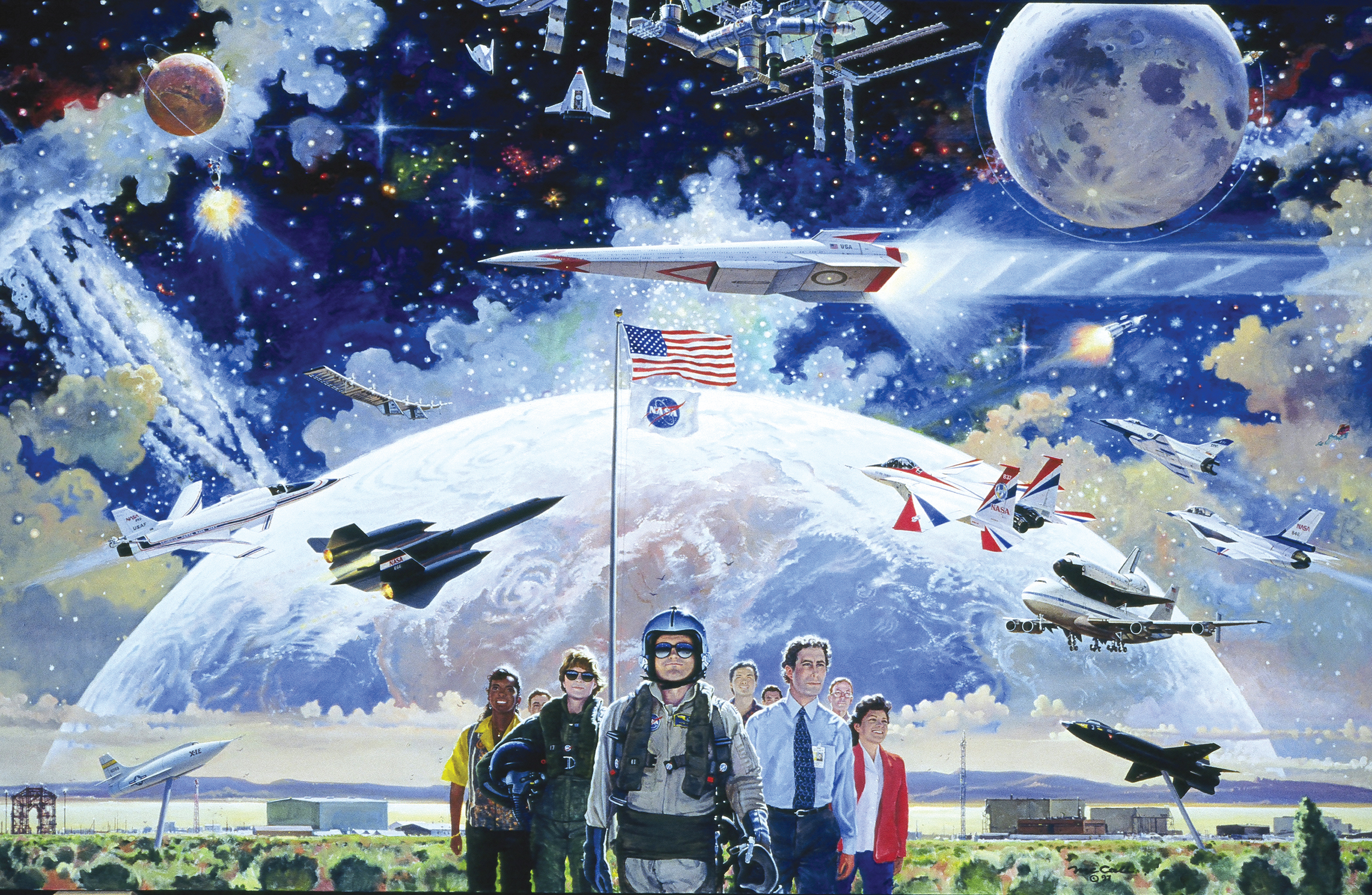By Bob Shane
The world of internationally renowned space artist Robert McCall knows no boundaries. Spanning the universe, both in time and distance, his artwork has chronicled the U.S. space program since inception and provided aerospace devotees an educated guess of what interplanetary space travel could look like in the future.
At 86, although he looks much younger, McCall is still driven by the same enthusiasm and vision that launched him into a lifelong career as a space artist, back in 1956, when he made the NASA connection. He continues to be optimistic about technology and the future, spreading a positive outlook that has never wavered, even in the wake of the Challenger disaster.
An Arizonan for the past 36 years, McCall’s canvases and illustrations, the trophies of a prolific life long career, adorn the walls of his studio and spacious home, built on a picturesque hillside in the upscale community of Paradise Valley. It’s in this sanctuary, which McCall shares with the other artist in the house, his wife Louise, that he does most of his painting. The couple met when she was a 19-year-old art student. They have been partners in art and happily married for 61 years. An accomplished artist, her impressionistic portraits and paintings of flowers brighten up many of the rooms in the McCall home.
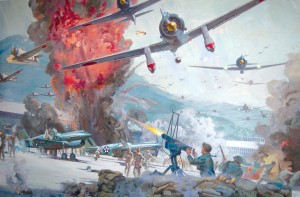
One of a series of paintings Robert McCall produced promoting the 1970 blockbuster movie “Tora! Tora! Tora!” clearly shows the intensity of the attack on Wheeler Field.
Being an Arizona resident, it’s only fitting that McCall have a major work of art on local display. In downtown Phoenix, at the Industrial Commission Building, is McCall’s multi-story mural entitled “The Spirit of Arizona.” The panorama depicts the history of the state, past, present and future. McCall collaborated with his wife, who painted the beautiful wildflowers displayed in the foreground of the mural. This was McCall’s longest project; it took one and a half years to complete.
“Centennial of Flight”
In 2003, the nation celebrated the 100th anniversary of man’s first powered flight, made by the Wright brothers. When NASA commissioned McCall to paint the “Centennial of Flight” mural, he was ecstatic.
“When I received the commission, I thought, ‘This is just what I would love to do, more than anything. I want to make a painting that brings together all of my great passions as an artist and paint the subjects that have driven me intellectually and professionally for a lifetime,'” he recalled.
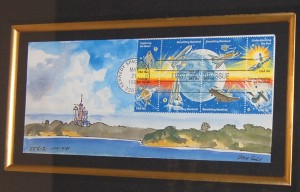
Bob McCall designed 24 postage stamps for the U.S. Postal Service, including this group of eight stamps cancelled on May 21, 1981, depicting man successfully penetrating the frontier of space.
McCall immediately went to work gathering the requisite information, organizing it so that it would tell a logical story on a timeline that reads from left to right and chronicles the evolution of powered flight. In the center of the painting is the rising sun, with the Wright brothers’ first flight silhouetted against it.
“It’s symbolic of the rising future of aviation and all that it entails,” McCall said. “The Wright Flyer is so significant in the composition; it’s a detail and an element that the whole concept is built around. Dominating this panorama of action and activity and accomplishment and vehicles that have made history, it was important to point out that without the human element none of this could have happened. Thank God there are in this world those people with a spirit of adventure that just won’t be denied. People who are willing to risk everything to achieve certain goals; often they are worthy goals, because it allows the rest of humanity to follow them and gives courage to those that follow.”

Robert McCall painted this Centennial of Flight master study, which contains more aircraft than the larger original mural on display at the NASA Dryden Flight Research Center.
In addition to the original 6-foot by 18-foot mural, which is on display at the NASA Dryden Flight Research Center in Edwards, Calif., McCall painted a two-foot by 6-foot master study. This finished piece of art contains many more aircraft than the NASA mural. It was difficult for McCall to leave out aircraft that were historically significant. This resulted in a feeling that the piece was esthetically too crowded. McCall was taught when he was very young, “Simplicity is the keynote to all great art.”
It’s the artist’s wish that the viewer of the mural feel, “Wow! Haven’t we done marvelous things and don’t they look marvelous?” He said the painting should “lift the spirit” and that he hopes that people, particularly young people, will be inspired by it. He wants the viewer to understand that his work of art is “a document of achievement that our nation can be proud of.”

Robert McCall uses rainbows, such as this one in “The Spirit of Arizona” mural, to symbolize happiness and prosperity.
Hearing McCall’s description of the mural, in his own words, provides a philosophical insight into the creative mind of a master painter and enhances one’s understanding and appreciation of a truly profound work of aviation art. McCall is a visionary whose prodigious imagination has been effectively captured in oils, acrylics and watercolors for more than half a century. The majority of his work is optimistic, celebrating the joy of living, man’s technological progress and the many wonders in nature.
McCall has a profound respect for nature. In his book, “The Art of Robert McCall,” published in 1992, he says, “I have the conviction that nature always is the master and that nature is so magnificent, so awesome in every aspect, that to even attempt to capture it in a painting is almost absurd. Nevertheless, we all try, we artists.”
The dawn of an art career
McCall was born in Columbus, Ohio, in 1919.
“I recognized I had a certain skill for drawing in elementary school,” he said. With his mother’s support, McCall decided “art was in the forefront of my intellect.”
His first painting, at age 15, for which he received compensation, was of an Irish setter he painted for his dentist. McCall did his first serious commercial work at age 16; he was paid $25 for the drawing of a water purification plant he did for an engineering firm.

Robert McCall’s “Spirit of Arizona” mural—a panorama of the history of Arizona, past, present and future—can be viewed in the lobby of the Industrial Commission Building, located in the downtown area of Phoenix.
McCall also found he had an interest in science. In 1933, he attended the Chicago World’s Fair. He was inspired by what he saw there, which included aircraft displays.
Growing up in Columbus, Ohio, put him close to the city of Dayton. McCall remembers seeing lots of action in the sky, including airplanes being flown in mock combat demonstrations. He now had a passion for flight. So much so, he later enlisted in the Army Air Corps, where he became a bombardier on a B-29.
He attended the Columbus College of Art and Design on a scholarship and became a professional illustrator.
“I did anything that came my way,” he said.
He worked for Ziff Davis publishing and had Ford Motor Company for a client; his automotive art was used in magazine ads. He had many spreads in Newsweek and Time magazine and his illustrations could be found in Colliers, Popular Science and Field and Stream. He even did romantic illustrations for the Saturday Evening Post.
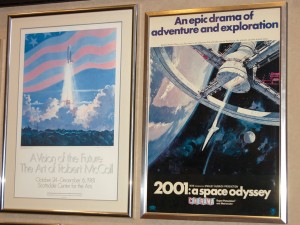
These posters on display at the Industrial Commission Building in Phoenix illustrate the scope of Robert McCall’s space art, from an operational shuttle to the futuristic space wheel in the movie “2001: A Space Odyssey.”
In those days, McCall’s artwork seemed to be everywhere. Then, in 1956, he went to work for Life magazine. This proved to be a defining event that would profoundly shape McCall’s future career as an artist. Life sent him to Washington D.C. and Cape Canaveral to cover the nation’s fledgling space program.
“My outstanding work was for Life magazine,” he said.
His entrée into NASA signaled the beginning of a lifelong career, documenting the space program using brushes and paints. NASA provided McCall with a front-row seat during all of the space launches, and McCall provided NASA with vivid renderings that captured the drama, action and brute force of its soaring rockets. His illustrations and paintings recorded it all, from Mercury to Gemini, to Apollo, to the space shuttle and the stars beyond.
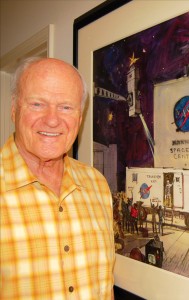
This early Mercury program sketch shows astronaut Gordon Cooper standing in the doorway of the NASA transfer van.
When speaking of his art, McCall says, “My work is a vision of the future that I endeavor to graphically portray.” Isaac Asimov once described him as “the nearest thing to an artist in residence from outer space.” His images are said to celebrate the human spirit and man’s quest to explore and comprehend the vast universe in which he finds himself.
NASA space art
McCall’s “Opening the Space Frontier—The Next Giant Step,” is a sizeable 16-foot by 72-foot mural displayed at the Johnson Space Center. This 1979 painting depicts the first two decades of American space exploration, starting with Mercury and the first manned space flight of astronaut Alan Shepard on May 5, 1961, to the Gemini, Apollo and space shuttle programs that followed in the 1970s and 1980s. The mural includes a look into the future when permanently manned space stations will routinely orbit the earth.
McCall’s painting, “First Men on the Moon,” done in 1971, captures the moment on July 20, 1969, when Neil Armstrong and Edwin “Buzz” Aldrin became the first humans to walk on the moon. In another mural, “Stairway of Humanity,” McCall collaborated with Andrei Sokolov, one of the Soviet Union’s most renowned space artists, to produce a 6′ x 9′ painting that recognizes the accomplishments of the first three decades of U.S./Soviet efforts in space.
There were both ups and downs in the space program. In 1981, McCall did an oil painting depicting the first successful launch of the Space Shuttle Columbia from the Kennedy Space Center, capturing all the fire and brimstone that such a launch entails. Then in 1987, he painted a commemorative piece on the last flight of Challenger, on Jan. 28, 1986.

Inspired by a recent NASA project, McCall’s current painting, now taking shape on the easel in his studio, provides insight into what a mission to Mars might look like.
Flight research has been a big part of NASA’s activities. In 1977, McCall painted his 10′ x 20′ mural, “The Spirit of Flight Research.” It was a graphic portrayal of experimental NASA aircraft, the space shuttle and its B-747 carrier, Chuck Yeager’s X-1, Glamorous Glennis, and the rocket-powered X-15, which advanced the speed record from Mach 3 to Mach 6.
In 1982, McCall put brush to canvas to create “The Spirit of NASA” for the Disney Corporation. On display at Epcot Center in Florida, it profiles the hundreds of support personnel, scientists and technicians and support aircraft that are essential to the success of every mission. It shows John Young and Robert Crippen preparing for the maiden flight of Columbia.
McCall’s canvases have captured the moment in every major space event, and his infinite vision and soaring imagination have provided us all with insightful views of man’s possible future in space. This seemingly endless stream of art has depicted everything from tomorrow’s weapons, such as a nuclear-powered beam weapon, striking targets from its orbital track high above the earth, to establishing an outpost on Mars. Other subjects include looking for primitive life forms in space; exploring the asteroid belt between Jupiter and Mars; and floating cities, where, by transcending gravity, we’ll be able to move the structure in which we live and work to any place desired.
Movies, stamps and mission emblems
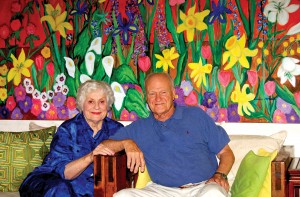
Artists Louise McCall and Bob McCall relax beneath one of her paintings, which she calls “The Garden.”
Motion picture companies have commissioned McCall to produce concept drawings and paintings used to promote several feature films, including “Tora! Tora! Tora!” The artwork was used in promotional advertising for the film, which told the story of the attack on Pearl Harbor. All paintings were part of a major six-month exhibit at the Museum for the Performing Arts at Lincoln Center in New York City. McCall was also commissioned to do promotional art for Stanley Kubrick’s “2001: A Space Odyssey,” “Star Trek: The Motion Picture” and Disney’s “The Black Hole.”
McCall designed 24 space-themed postage stamps for the U.S. Postal Service, two of which were cancelled on the moon. He also designed the mission emblem for the first space shuttle flight, STS-1.
Today, McCall remains very active; although admittedly slowed down a little, he continues to paint. His pet project is overseeing the construction of the Robert McCall Museum of Art, which will provide a showcase for his unique and very special space-oriented art collection. It’s very unusual for one artist to own and possess such a large number of his original paintings. The collection consists of nearly 500 pieces, one-third of which are framed. Additionally, there are numerous sketchbooks and drawings.
McCall is currently considering several possible sites in Phoenix and Tucson to build the museum. This world- class art collection will be a valuable educational and cultural addition to any community fortunate enough to receive it.
Robert McCall is undoubtedly the premier space artist of our time, and in many circles, already regarded as the “Father of Space Art.” For a man who has dedicated his career to documenting NASA and the nation’s space program, the museum will be a perfect legacy.
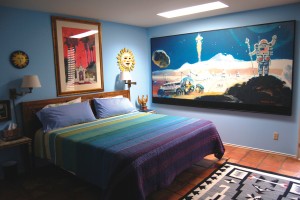
The artwork of Louise and Bob McCall is displayed throughout their beautiful home. This large painting of the surface on Mars can be found in one of the guest rooms.
You can find more information on the art of Robert McCall at [http://www.mccallstudios.com]











